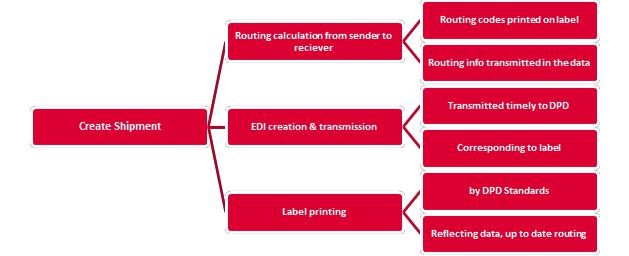Onboarding step by step
- Customer & DPD Account Manager: Contract agreement sign off
- As a part of the contract agreement ‘Self integration’ is chosen.
- Internal or External IT makes contact with DPD BU
- Establishing an IT project team on customer side and connecting it to DPD BU CIT support.
- Defining roles and responsibilities with 3rd parties.
- Onboarding process explained + Documentation transfer
- The DPD BU CIT delivers the last version of all required documents and data sets.
- Development and feedback loop
- Development begins at customer side.
- All support and progress is centralised at DPD side.
- Validating Data
- Validating Label
- Validating Routing
- 5 – 6 – 7 are separate validations
- Mandatory DPD approval before proceeding to testing. o Feedback is provided to overcome gaps.
- Go Live test
- Proceeding to DPD prescribed testcases without actual operational shipping.
- Measuring results until compliance is attained and moving accordingly to step 4 or 9
- Go Live
- Gradual go live with volumes as intended in accordance with operational and commercial agreements.
- Monitoring first activity
- DPD monitors the first data flows and performance as a safeguard.
- Agreement on quality and updates (data/label/routing)
- As a final step and ongoing quality assurance, DPD goes through the requirements with the customer for lasting data and label quality and to update routings as required. The customer commits to this way of working.
- The customer assigns a dedicated support contact to own the DPD integration.
The onboarding process will be guided by the BU that owns your primary commercial account.
Slight variations in the sequence of steps may occur, but as a whole, the roadmap is identical. You can find the contacts for development questions as well as label approval per BU in the table listed below.
Steps to success:
Goal of the development process visualised

Important
During Development, the customer must perform the development tests against the correct environment of the BU. The stage environment must be used for development and testing purpose only, the production environment must only be used for production purposes.
Validation of Labels is needed even if the data inputted is correct. This is important to check the label layout, parcel number, service code, font size, printing quality, etc. The customer will be asked to send over actual printed labels for validation before go-live. This needs to be checked by the specific BU who is integrating the Customer and validated with actual physical scans and a physical label test.
Test parcels can only be created after permission of the DPD BU.
Data transmission for shipments needs to be received in time by the DPD BU. The standard rule is max. 10 days before the physical arrival of the shipment in a DPD depot. Data transmission must always occur before the parcel is presented physically to the DPD operational network.
Go Live is the last step in the process when the development tests are done and are confirmed. The BU and Customer must agree on success before go live.
Parcel Tracking and parcelshop location retrieval is not covered in this document nor in the referred to documentation from chapter (2). Please contact the DPD BU for possibilities in this area.
End of Day list printing is an optional development on your side. There are no DPD IT cross BU standards here.
Timing and development duration. Please take into account the entire process will take up a few weeks to months from kick off to go-live. When multiple BU’s are included more alignment will be needed. The go live date will mainly depend on customer resources and efforts.
